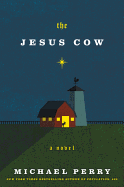
| Publisher: | Harper | |
| Genre: | Humorous, Fiction, Satire, Literary | |
| ISBN: | 9780062289919 | |
| Pub Date: | May 2015 | |
| Price: | $25.99 |
| Starred | Fiction |
by Michael Perry
Humorist Michael Perry (Coop) makes a foray into fiction with The Jesus Cow, a novel about a small town transformed in profound and hilarious ways by a bull calf born in a barn on Christmas Eve.
Perry sets the story in Swivel, Wis.--population exaggerated at 562--only visible from the interstate by a long-stemmed, halogen-lit Kwik Pump gasoline sign whose "logo glows against the sky." He focuses on resident Harley Jackson, who lives in the house where he grew up, on 15 acres of deteriorating farmland. When his prized cow, Tina Turner, delivers a bull calf bearing the image of Jesus Christ on its black-and-white patchwork hide, Harley, a born-again believer, doesn't drop to his knees. Instead, he says, "Well, that's trouble."
Whether the calf was marked by God or not, Harley doesn't want anything to disturb his manageable, unassuming life, but when the Jesus calf escapes from the barn, the animal's image goes viral. Harley's upper Midwest farm soon becomes an international spiritual destination--a circus that sends the town residents into a tizzy.
As in Truck: A Love Story and Visiting Tom, Perry once again delivers his own brand of outlandishness through rich, endearing characterizations of quirky small-town folks, and how their zany foibles and flaws mask underlying disappointments, secrets and longings. By deploying humor in depicting the often painful truths and absurdities of life, Perry successfully makes much larger statements about society and the human condition. --Kathleen Gerard, blogger at Reading Between the Lines
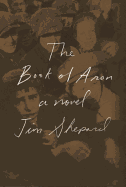
| Publisher: | Knopf | |
| Genre: | Jewish, Fiction, Coming of Age, Literary | |
| ISBN: | 9781101874318 | |
| Pub Date: | May 2015 | |
| Price: | $23.95 |
| Starred | Fiction |
by Jim Shepard
Following two distinctive and critically praised short story collections, Like You'd Understand, Anyway and You Think That's Bad, Jim Shepard has written a novel for the first time in a decade. In The Book of Aron, he imagines the early years of the Warsaw Ghetto through the eyes of an adolescent whose life intersects with that of Janusz Korczak, the real-life doctor whose struggle to save the lives of some 200 children in his orphanage was one of World War II's great tales of heroism. Perfectly channeling the artless voice of his young narrator, and with impressive restraint, Shepard gives readers a glimpse of the nightmare world of Warsaw's Jews.
Aron Różycki has just celebrated his 10th birthday when the Germans invade Poland, and it's only a few months before the Nazis construct the walled quarter into which they herd the city's Jews. After his father and brother are transported to a labor camp and his mother dies, Aron lands on Korczak's doorstep.
Shepard makes no attempt to exaggerate the terror and bewilderment of the children under Korczak's care. The ones who don't starve succumb to typhus, spread by the lice that infest everyone. Aron accompanies an ailing Korczak on daily trips through the ghetto's streets, begging and bartering for scraps of food. But through all this, as Shepard shows with profound compassion, the doctor's love nourished his charges as much as any physical sustenance. The Book of Aron ennobles unimaginable suffering through the gift of art. --Harvey Freedenberg, attorney and freelance reviewer

| Publisher: | Crown | |
| Genre: | Suspense, Fiction, Mystery & Detective, Coming of Age, Thrillers, Contemporary Women, Literary, Women Sleuths | |
| ISBN: | 9780553418057 | |
| Pub Date: | May 2015 | |
| Price: | $25 |
| Fiction |
by Lauren Frankel
Lauren Frankel's debut novel, Hyacinth Girls, opens when Rebecca puts Callie's face, along with a provocative question, on a billboard near the high school. A lengthy flashback explains why, in a gradual uncovering of the past. Callie is not Rebecca's daughter but the daughter of her late best friend, Joyce. The happenings and drama of Callie's middle and high school years are more troubling than the average teen experience, and have led to some terrible events that call for a billboard. But what exactly happened, and who is the perpetrator and who the victim, and why? These are questions that take the whole book to unravel, with roles reversing throughout. Rebecca's voice alternates with Callie's, but not until late in the book, when the reader's impressions are already formed. The mixing up of clues and the struggle to sort out loyalties results in an unreliable narrator or two.
The story of Callie and her social circle eventually becomes entangled with that of Joyce and Rebecca, when they were childhood best friends. New and old traumas slowly, coyly come out: bullying, suicide, simple mistakes and basic meanness. Betrayals and lies populate the experiences of both generations. In revealing a complex web of family and community secrets, schoolyard bullies and the nature of trust, Frankel nudges her reader to ask questions like the one Rebecca puts on the billboard: Do you know your children?
Hyacinth Girls is a compelling and powerfully evocative novel of friendship and love, deceit and duplicity, and the rough terrain of being a teenage girl. --Julia Jenkins, librarian and blogger at pagesofjulia

| Publisher: | Morrow | |
| Genre: | General, Fiction, Romance, Literary | |
| ISBN: | 9780062358325 | |
| Pub Date: | May 2015 | |
| Price: | $25.99 |
| Fiction |
by Charles Dubow
In Girl in the Moonlight by Charles Dubow (Indiscretion), Wylie Rose has known the Bonet siblings since he was 10, when he fell out of a tree and broke his arm at a party on their massive estate. He studies painting with the elder son, who becomes a dear friend; he admires the younger twins and the rest of the family, who are all brilliant, luminous, talented, beautiful and tremendously rich. But it is Cesca, two years older than Wylie, who hypnotizes him, and ruins him for any other woman or any other life than self-destructive devotion to her.
From a distance of decades, adult Wylie reflects on that life--always coming when Cesca called, from their first sexual encounter when he was a teen through her unpredictable comings and goings over the years, and the apparently mature and healthy relationships he throws aside for her in Manhattan, Paris and Barcelona. She seemingly can't help her flirtations, manipulations and self-destructive behaviors. Wylie feels for her like "an exile misses his homeland or an old man misses his youth."
Dubow's writing is a bit uneven, but often inspired in its phrasing, evoking a mystical atmosphere around Cesca's mesmerizing power and the rarefied world she travels in: extraordinary wealth, titles and estates around the world, artistic success and broken hearts. Wylie and Cesca see tempestuous years pass in struggling to define the magnetism they feel for one another, and readers will be spellbound by the process. --Julia Jenkins, librarian and blogger at pagesofjulia
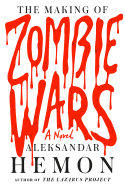
| Publisher: | Farrar, Straus & Giroux | |
| Genre: | Humorous, Fiction, Literary | |
| ISBN: | 9780374203412 | |
| Pub Date: | May 2015 | |
| Price: | $26 |
| Fiction |
by Aleksandar Hemon
Aleksandar Hemon is a very sneaky writer, which he's proven in works like The Lazarus Project, a story with photographs that was both true and entirely fictitious. But the best example of his guile is in his acknowledgements for The Making of Zombie Wars, where he thanks his agent for "not moving a muscle on her face when I told her I'd written a novel she'd known nothing about." The Making of Zombie Wars is an entirely different animal than Hemon's most famous works. Instead of his usual project of forcing readers to confront assumptions about the story he presents, here he forces them to confront assumptions about his overall narrative project.
Joshua Levin, a failed screenwriter and ESL teacher, begins a tryst with his married Bosnian student, which leads to a farcical series of events that grow ever more dangerous and absurd. Scenes from Josh's latest script, a horror movie called Zombie Wars, make up the chapters that don't chronicle his failures as a womanizer and functioning adult. As the novel continues, the script and Josh's life begin to merge. A neurotic Jewish writer in his 30s seems a strange protagonist for a Hemon novel, considering his life as a refugee from Bosnia permeates the rest of his work, but that may very well be the point. The Making of Zombie Wars cheekily skewers the archetypal "Jewish artist" protagonist in American literature even as it shows that Hemon has a wider range than he's ever shown before. --Noah Cruickshank, marketing manager, Open Books, Chicago, Ill.

| Publisher: | Knopf | |
| Genre: | Fiction, Family Life, Short Stories (single author), Literary | |
| ISBN: | 9780385351539 | |
| Pub Date: | May 2015 | |
| Price: | $25.95 |
| Fiction |
by David Gates
A Hand Reached Down to Guide Me is David Gates's first book of fiction in 15 years, and once again he mines the same rich lode of broken (or at best, bent) lives beneath the surface of New England professionals and academics. In story after story, musicians, doctors, architects and especially journalists descend into drink, divorce and promiscuity. They are getting old, and their careers and dreams have long passed. Sounds bleak, but over the years Gates has honed his sense of irony and sad humor. His characters' smart, often sarcastic dialogue reflects the hard-earned knowledge of people approaching the end.
Perhaps because its length gives Gates room to turn snapshots into a panorama, the opening novella, "Banishment," is the best piece. Its narrator is a snarky, on-again, off-again journalist who took an entry-level job at a Hudson Valley newspaper and married an earnest colleague. She leaves her first husband to marry an architect in his 70s, despite his warning that "things could get a little unattractive in the homestretch." She later leaves him for a surprising new sexual partner and a job at an even lower tier news outlet. Like most of Gates's stories, "Banishment" doesn't conclude so much as just end.
In "A Hand Reached Down to Guide Me," the narrator, who accepts his dying friend's request to take him in and nurse him through his final days, comments, "I don't know what to hope for.... Quality, I guess. And then not too much quantity." Whatever Gates's oeuvre might lack in quantity, it more than makes up for in quality. --Bruce Jacobs, founding partner, Watermark Books & Cafe, Wichita, Kan.

| Publisher: | Bloomsbury | |
| Genre: | Fiction, Short Stories (single author) | |
| ISBN: | 9781620400852 | |
| Pub Date: | May 2015 | |
| Price: | $26 |
| Fiction |
by Ken Kalfus
In the opening novella of Ken Kalfus's third book of short fiction, Coup de Foudre, an international banker writes an incriminating e-mail to his illiterate rape victim. In events that play out much the way they did during the real-life Dominique Strauss-Kahn controversy, the hubristic narrator escapes conviction but, in Kalfus's imagination, cannot quiet the troubling voices in his head.
The stories that follow explore the world through the eyes of similarly troubled people, but because of the magical and twisted realities in which they live, consequences are never quite as dire as they should be. A town cursed with the knowledge of when each citizen will die submits to its fate. A man inexplicably unable to rise from a park bench wonders whether it's the bench or his own mind that's imprisoned him.
The title of the collection translates literally to "bolt of lightning," but the phrase is a French idiom that means "love at first sight." It's an expression Kalfus's narrator in the novella uses to explain how he loves, "without the oversignificant looks and the lame jokes, in a sudden strike, a jump, a rage--a coup de foudre...."
Kalfus's stories tend to roll in like thunder, rather than flash like lightning. The stories are separate and distinct but together they create a pensive and wistful atmosphere. Kalfus (Equilateral) blends science and philosophy to create whimsical, off-kilter worlds only slightly different from our own and in which entire universes are born--slanted but familiar. --Josh Potter
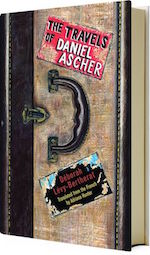
| Publisher: | Other Press | |
| Genre: | Jewish, Fiction, Sagas, Literary | |
| ISBN: | 9781590517079 | |
| Pub Date: | May 2015 | |
| Price: | $22.95 |
| Fiction |
by Deborah Levy-Bertherat, trans. by Adriana Hunter
Countless books and films have explored the Holocaust and its effects on those who survived. While estimating the number of lives ultimately affected and the myriad ways in which it shaped them is impossible, the subject inspires ongoing introspection: How much more trauma can original trauma beget, and how can human beings ever move forward once touched by such horrors? In her tightly layered debut novel, The Travels of Daniel Ascher, Déborah Lévy-Bertherat imagines a man haunted by his World War II childhood, and a family marred by the secrets of the past.
Even as a little girl, Hélène Roche had always found her great-uncle Daniel gauche and embarrassing. The odd one out in a family as sedentary as hobbits, Daniel Roche came to reunions wearing a coat with as many pockets as he had fantastical stories of his world travels. While he held the other children spellbound with tall tales of his daring escapades, Hélène stood unmoved. Her immunity to his charm also extended to The Black Insignia, the bestselling children's adventure series Daniel wrote under the name H.R. Sanders, beloved by her brother and children the world over.
Now a young woman studying at the Institute of Archaeology in Paris, Helene moves into a room Daniel offers her in his nearby apartment building. When hearing her fellow students discussing their excavation experiences, "She thought she'd be a beginner for the rest of her life." However, her work on a children's cemetery dig earns their respect, and her relation to Daniel catches the attention of classmate Guillaume. Like most of their contemporaries, Guillaume grew up on the exploits of Peter, hero of The Black Insignia. He cannot believe Hélène never read the series; imagine having J.K. Rowling as your aunt but never reading Harry Potter. Partly spurred by Guillaume's fascination with Daniel when she introduces them, Hélène becomes curious about her great-uncle and his work. She knows her family adopted Daniel during WWII and successfully hid his identity as a Jewish orphan from the authorities. However, as she investigates his past, every inquiry gives way to more questions about his birth family, the Aschers, and his separation from them, as well as his place in the Roche clan. She begins to scrutinize The Black Insignia,too, trying to work out certain plot discrepancies that have bothered its fans for years, searching beneath the façade of series hero Peter for the true face of Daniel. Her hunt for the truth takes her both across the ocean and into the secrets of her Paris neighborhood, and introduces her to previously unseen sides of her relatives, as well as several strangers, including a concentration camp survivor who tells her, "I wouldn't say I saw death up close in Birkenau. I was inside it, you see.... I was right inside death."
The size ratio between story and page count of this novel somewhat resembles a circus clown car act: the reader opens this petite book to find a sprawling, expansive story. Lévy-Bertherat accomplishes this feat not through sleight-of-hand but through thoughtful construction and layers of meaning. That great pain can lead to great art is hardly a disputed concept, but Lévy-Bertherat encourages the reader to ask what that art represents--a grieving process, a healing catharsis, a hiding place from the pain itself? Readers will be left wondering if fiction can ever be purely false, or if some germ of the author's truth always enters into a work. Moreover, if fiction is a falsehood, does it have the same power to injure as outright lying?
Hélène's initially disaffected view of her great-uncle might reflect youth's customary disdain for elders, or perhaps Hélène senses even as a child that he represents a wrinkle in the fabric of her family. Despite her ambivalence, to the reader Daniel is at once a combination of enigma and the fantasy relative few of us had, one who traveled the world for months at a time and returned with presents and outrageous accounts of his swashbuckling adventures. Although he frequently absents himself from the narrative, when he appears, Daniel charms the reader with his eccentricity and a wistfulness Hélène fails to see at first. The traumas of his childhood, the loss of his true family, have in some ways turned Daniel into something of an adult Peter Pan, a lost boy who lives as a grown up but whose pain retains its immediacy from childhood. At one point, he even seems to fly like Pan, trying on a pair of new shoes and joking, "...this is great, now I'm like the poet Rimbaud, the man with soles of wind." While Hélène works to decide whether he is H.R. Sanders, bestselling author, Daniel Roche, outlandish world traveler, or Daniel Ascher, bereft Jewish orphan, the reader sees him shift among all three roles.
Before publishing a novel, Lévy-Bertherat translated works by Russian writers Mikhail Lermontov and Nikolai Gogol into French. With Daniel, she has created a man who constantly works at translating his past into a palatable story, while Hélène translates the family rumors and scraps of history into a cohesive narrative of Daniel's past. While the Holocaust certainly shaped Daniel's life, anyone who has tried to piece together a family history will relate to this translation loop. With an emphasis on our simultaneous needs to disguise our suffering and tell our stories, Lévy-Bertherat highlights a most human conundrum in a mystery whose resolution will fill readers with sorrow and hope. Ink sketches by Andreas Gurewich help to conjure the Parisian setting and give an air somewhat reminiscent of a children's story, leaving readers to wonder if they have experienced not just Lévy-Bertherat's novel, but a chapter of The Black Insignia as well. --Jaclyn Fulwood
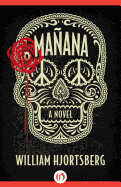
| Publisher: | Open Road Media | |
| Genre: | General, Noir, Crime, Fiction, Mystery & Detective, Thrillers | |
| ISBN: | 9781497680739 | |
| Pub Date: | May 2015 | |
| Price: | $13.99 |
| Mystery & Thriller |
by William Hjortsberg
William "Gatz" Hjortsberg hung around with the 1960s weed and whiskey writers crowd that included Ken Kesey and Richard Brautigan. In 2012, Hjortsberg published an 800-page biography about the tragic life of his friend Brautigan (Jubilee Hitchhiker), but his best known work is 1978's Edgar Award-winning juju-noir novel Falling Angel (source of the cult movie Angel Heart). His new novel, Mañana, goes back to those days when the adventurous and fugitive went down to kick back on Mexico's Pacific coast with cheap dope and sunshine. Married eight years, Tod and Linda leave the Summer of Love chaos in San Francisco to rent half a duplex in tiny Barra de Navidad for the 1968 Semana Santa celebrations. In a haze of music, surfing, sex, drugs and booze, they party with the next-door group of young ex-cons and dopers on the lam from a Beverly Hills jewelry robbery. Mañana launches with Tod waking from a drugged night to find a girl in his bed, her throat slashed, and Linda and the criminals gone. Packing up his broke-down VW microbus with Hawaiian shirts, leftover Pacifico beer and his back-up weed stash, he takes off to find Linda and learn who killed the girl.
Stoked with alcohol and doobies, Tod makes his way to the cities of Guadalajara and Guanajuato, following leads from loitering street and park pachucos who have heard about gringos trying to sell high-end watches. Hjortsberg's descriptions of Tod's wanderings are detailed right down to the cantinas, plazas and parking lots--clearly he's been there. Part hardboiled mystery and part road trip, Mañana is both an entertaining trip back to the tie-dyed days of sex and drugs and a dive into Mexican life, with its lucha libre, mariachis, tortas and bandidos. --Bruce Jacobs, founding partner Watermark Books & Cafe, Wichita, Kan.

| Publisher: | Morrow | |
| Genre: | Fiction, Science Fiction, Genetic Engineering, Apocalyptic & Post-Apocalyptic | |
| ISBN: | 9780062190376 | |
| Pub Date: | May 2015 | |
| Price: | $35 |
| Science Fiction & Fantasy |
by Neal Stephenson
When the moon explodes, no one knows why, how or who made it happen, but humanity needs to figure out what to do next, and fast.
Seveneves, another brilliant speculative novel in a long line from Neal Stephenson (REAMDE), documents the panic of astronomers as they observe the large remnants of moon scattering throughout the upper orbits of Earth, up to the moment--5,000 years later--when humanity, much-changed as a species, returns to its birthplace.
World leaders all hear the hard truth: what's left of the moon will first obscure the sun, then come down in a fiery rain of death and destruction, killing everything on the Earth's surface. The 10 astronauts on the International Space Station race to save the small number of people they can from the doomed planet; the evacuees carry with them digital records of the planet's genetic diversity, hoping to eventually return and re-seed Earth in the far future, once the "Hard Rain" of burning moon detritus has ended and the planet has healed.
Seveneves reads like three smaller novels, with sections one and two detailing humanity's last push to reach the stars, and the small space-bound contingent of human beings who survive. The third section explores what 5,000 years of space living might do to us as a species.
Stephenson brings his considerable intelligence, wit and ability to write engaging, believable characters to a tour de force of speculative fiction. A riveting book from beginning to end. --Rob LeFebvre, freelance writer and editor

| Publisher: | Knopf | |
| Genre: | Political Science, United States, General, History, History & Theory, Revolutionary War | |
| ISBN: | 9780385353403 | |
| Pub Date: | May 2015 | |
| Price: | $27.95 |
| History |
by Joseph J. Ellis
To the modern American, the United States seems a foregone conclusion of the Revolutionary War. But in The Quartet: Orchestrating the Second American Revolution, 1783-1789, historian Joseph J. Ellis (American Sphinx, First Family) argues that nationhood was not a goal of the Revolutionary War, and that at the end of the war, the only connection among the colonies was their resolve to remain free of empire. Comparable to today's European Union, the 13 colonies were a collaborative collection of independent entities.
The politics of the nascent nation changed rapidly between 1783 and 1789, due largely to a quartet of men: George Washington, John Jay, Alexander Hamilton and James Madison. Washington and Hamilton both witnessed firsthand the ineffectiveness of the Continental Congress, instilling in them a desire for a strong, central leadership. Jay spent years in Europe setting American foreign policy, which convinced him that the United States needed to appear united internationally. Madison's political genius made him certain that a confederation would never succeed.
These men were perfectly positioned politically to be able drastically to shift American policy away from boundless independence and back toward centralized authority. By establishing the Constitution and setting the framework of the federal government, in essence they staged a bloodless revolution.
Absorbing in its details, and convincing in its arguments, The Quartet is sure to appeal to history nerds and American politicos. As another election season approaches, a look back at the creation of the government, and the reasons why these founding fathers did what they did, is sure to be engrossing reading for anyone. --Jessica Howard, blogger at Quirky Bookworm
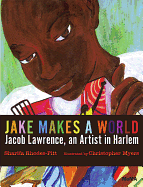
| Publisher: | The Museum of Modern Art | |
| Genre: | General, Juvenile Fiction | |
| ISBN: | 9780870709654 | |
| Pub Date: | May 2015 | |
| Price: | $18.95 |
| Starred | Children's & Young Adult |
by Sharifa Rhodes-Pitts, illust. by Christopher Myers
Jacob Lawrence (1917–2000) created the 60 panels of his the Migration of the Negro series in 1941 at the age of 23. This sumptuous slice-of-life biography with illustrations by Caldecott Honor artist Christopher Myers (Harlem) plants some seeds in childhood for the artist who would grow up to immortalize his era.
Sharifa Rhodes-Pitts (Harlem Is Nowhere), in her first book for young people, describes the young artist at 13, when he moves to Harlem: "In the morning Jake watches the sun wake up.... He makes a big stretch, and the sun stretches, too." In Myers's accompanying painting, Jake's arms dance above his head; the colors of the sunrise appear in the striped quilt on his bed. The author's lyrical words reflect an artist's view of the world. Jake's feet sink deep into a thick blue rug: "When his toes touch the ground, it's like a sky upside down." Myers skillfully pays homage to Lawrence while retaining his own style. Jake reaches toward Utopia Children's House, where he first met artist and teacher Charles Henry Alston. In one of Jake's paintings, "all the faces" he sees on the street "become one face," and after his teacher shows him an African mask, Jake fashions his own from brown paper bags, glue and paint. As Jake re-creates his street (the cover image), Myers invents a glorious mash-up of Lawrence's most famous figures.
Rhodes-Pitts and Myers imagine a young artist called to his vocation, who honors his city and history as subjects worth capturing for posterity. --Jennifer M. Brown, children's editor, Shelf Awareness

| Publisher: | City Lights | |
| Genre: | Juvenile Nonfiction, History, Biography & Autobiography, Women, Historical, United States/20th Century, Social Activists | |
| ISBN: | 9780872866836 | |
| Pub Date: | April 2015 | |
| Price: | $14.95 |
| Children's & Young Adult |
by Kate Schatz, illust. by Miriam Klein Stahl
From A for Angela Davis to Z for Zora Neale Hurston, this memorable abecedarian introduces readers to women leaders of community organizing, music, sports, writing and much more.
Kate Schatz introduces nearly all of the women by their first name (except for "G is for the Grimke Sisters," Angelina and Sarah), gives a one-line encapsulation ("who devoted their lives to the pursuit of equality"), followed by a sentence or two in large type in the color corresponding to the background of the illustration opposite, then provides a few paragraphs of details about each woman's life and work. Miriam Klein Stahl's cut-paper portraits pulse with energy, whether it's an image of Billie Jean King wielding her tennis racquet, or "Queen Bessie" Coleman alongside her biplane. The individuals alone will inspire young people, but as a collective, they demonstrate that each woman's pursuit of staying true to her vision--whether it be dance, preserving nature or designing a war memorial--furthers women's rights as a movement. Some readers may wish for references (e.g., for direct quotes from Carol Burnett and activist Jovita Idar, and a timeline for each woman within her biography, even though it's in the front matter), but most will appreciate the span of this diverse range of women and their vocations.
Author and artist place well-known personalities alongside everyday heroes, and show that you can't have one without the other. --Jennifer M. Brown, children's editor, Shelf Awareness